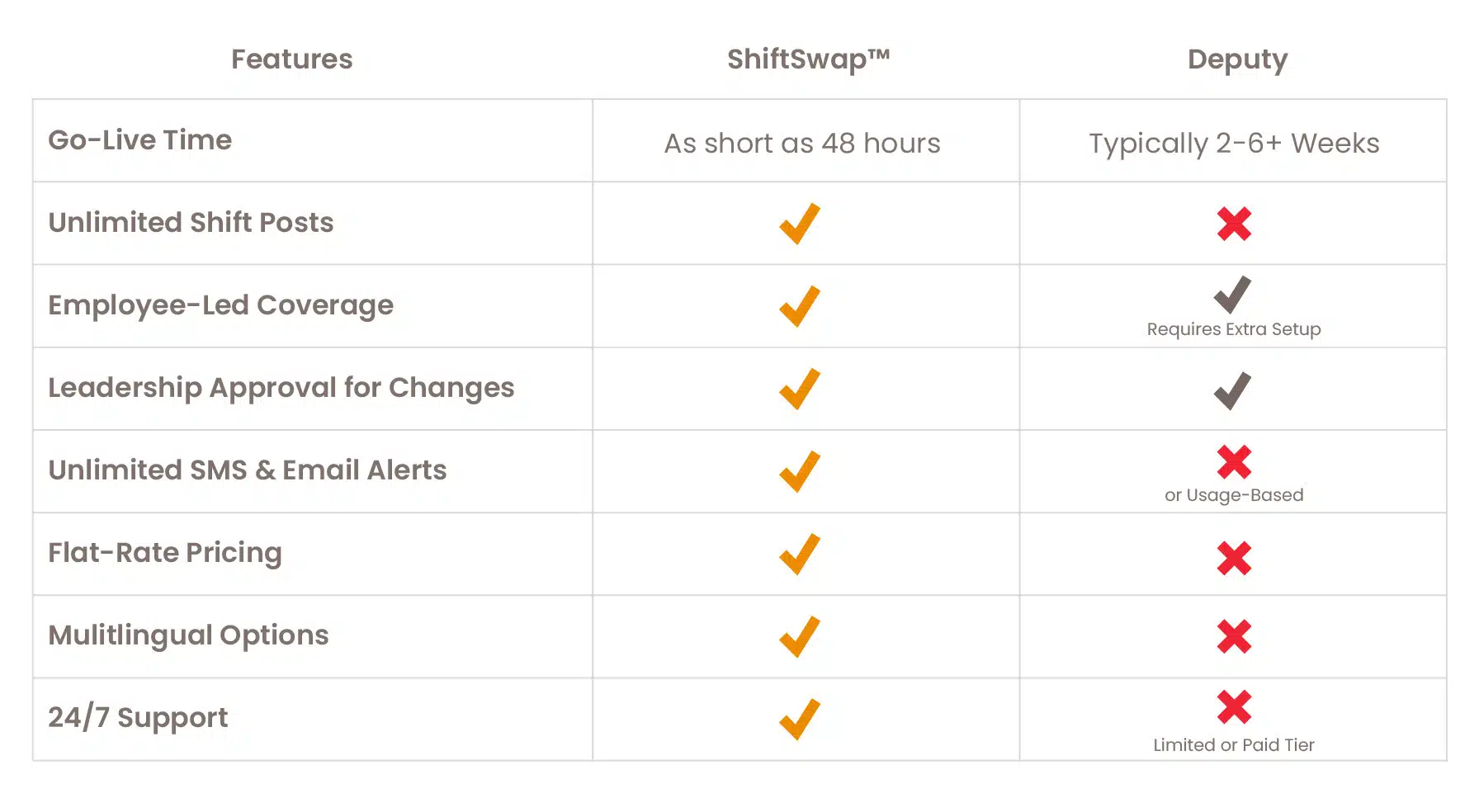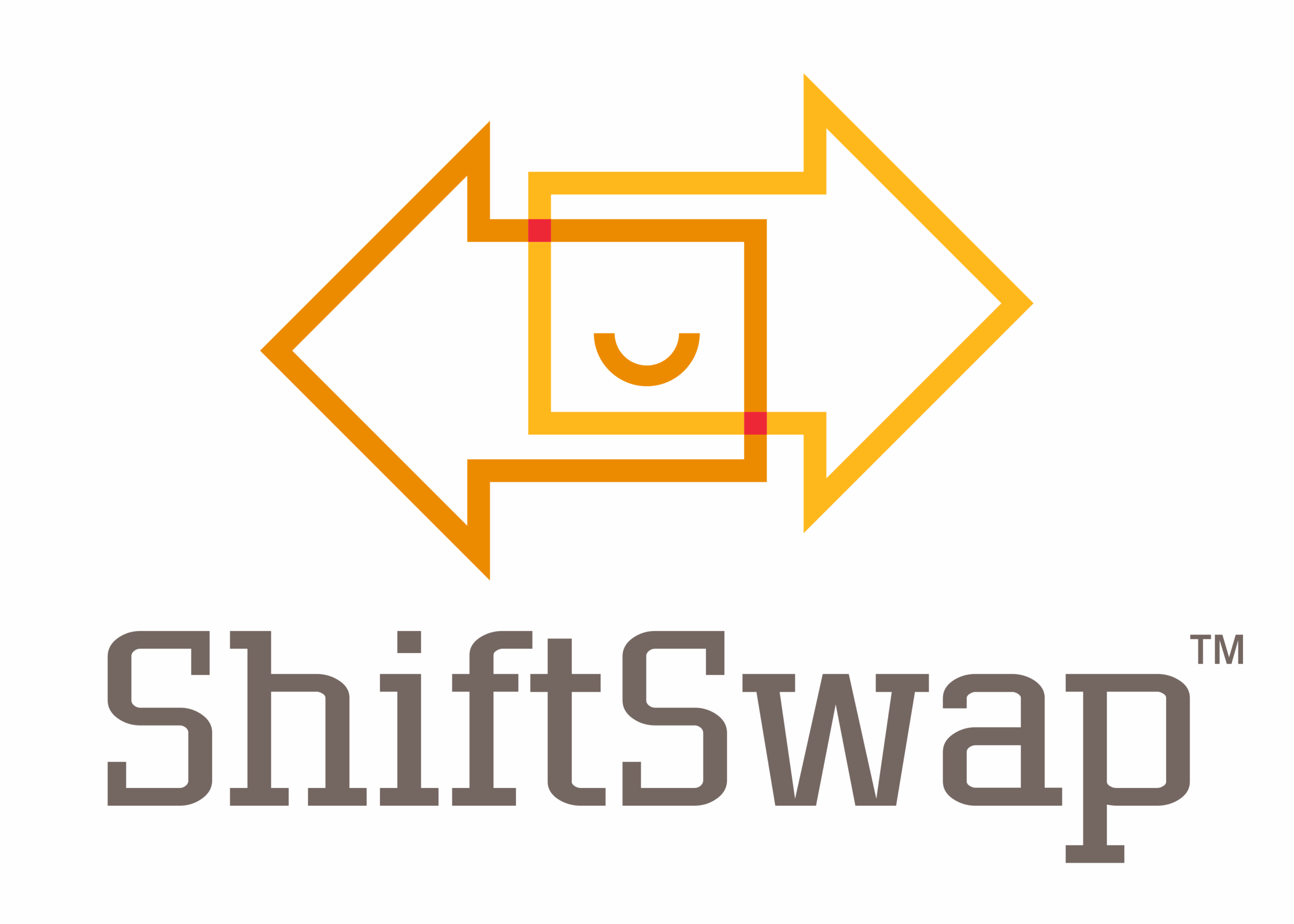
ShiftSwap vs Deputy
ShiftSwap and Deputy both offer workforce management tools, but ShiftSwap is uniquely positioned to serve dynamic industries that prioritize flexibility, labor cost reduction, and operational control.
Key Differences
Flexible, Employee-led Shift Coverage
Deputy supports shift exchanges and open shifts, allowing employees to request trades or cover shifts. Rules are in place to enforce compliance, including guidelines for avoiding overtime and adhering to maximum hours.
ShiftSwap adds leadership approvals, unlimited notifications per coverage request, and greater control to ensure fairness and prevent hidden costs.
Management & Scalability
Deputy supports businesses across multiple locations, allowing managers to build schedules per location, monitor compliance, and aggregate reporting.
ShiftSwap has features tuned for large and distributed hourly operations. The Campus Module feature is also set up for companies with sites at multiple locations.
Demand-Based Scheduling
Deputy provides labor demand forecasting, wage to sales data, and AI-assisted auto-scheduling to adapt to peaks/troughs in demand.
ShiftSwap also supports aligning workforce size with operational demand, but focuses on enabling leadership to rapidly flex labor by posting full and/or partial shifts, including Voluntary Time-Off (VTO) and Overtime, while maintaining engagement and morale.
Employee Engagement Tools
Deputy includes tools like Shift Pulse+ to track team mood, performance feedback, and employee satisfaction via surveys.
ShiftSwap emphasizes giving employees more autonomy over their shifts, which research shows strongly correlates with retention, morale, and satisfaction.

- You need rapid deployment, quick shift coverage for hourly workers, and a simplified system focused on reducing labor costs and turnover.
- You want consistent coverage, fairness, and improved employee morale, along with efficient administrative overhead.
- You want consistent execution of labor plans with tools that support both supervisor control and employee flexibility.
- You need strong forecasting and analytics dashboards, especially tied to sales or POS data.
- You want robust mobile access and user feedback tools.
- Your business has multiple locations and requires unified scheduling and compliance across all sites.
measurable operational improvements
Performance Comparisons
Go-Live Time
ShiftSwap: As short as 48 hours with complete onboarding and 24/7 support.
Deputy: Implementation typically takes 2-6 weeks, depending on setup, data migration, and training requirements.
Turnover Reduction
ShiftSwap: Customers report up to 70% decrease in turnover within the first 3 months of launch due to flexible shift management and autonomy.
Deputy: Deputy helps reduce administrative workload but doesn’t report directly turnover reduction data.
Absenteeism Improvement
ShiftSwap: Users see attendance improvements of up to 8%, thanks to better coverage and fewer no-shows.
Deputy: Provides absence tracking and reports by location, helping managers identify trends and problem areas.
Labor Cost Reduction
ShiftSwap: Automatic labor cost optimization, reducing unnecessary overtime and aligning labor with demand.
Deputy: Their forecasting tools help manage wage-to-sales ratios by requiring manual configuration.
Employee Engagement
ShiftSwap: Employee satisfaction rates increase, in some cases 7% increase on the Gallup score in 1 year. Empowering workers with more shift control and flexibility.
Deputy: They offer Shift Pulse+ surveys for feedback and morale tracking to keep an internal track of engagement.
Alerts & Notifications
ShiftSwap: Includes unlimited SMS and email alerts for the entire shift coverage process, ensuring leadership and employees stay connected and up to date.
Deputy: Provides limited notifications depending on your plan and role permissions.
Go-Live Time
ShiftSwap: As short as 48 hours with complete onboarding and 24/7 support.
Deputy: Implementation typically takes 2-6 weeks, depending on setup, data migration, and training requirements.
Turnover Reduction
ShiftSwap: Customers report up to 70% decrease in turnover within the first 3 months of launch due to flexible shift management and autonomy.
Deputy: Deputy helps reduce administrative workload but doesn’t report directly turnover reduction data.
Absenteeism Improvement
ShiftSwap: Users see attendance improvements of up to 20%, thanks to better coverage and fewer no-shows.
Deputy: Provides absence tracking and reports by location, helping managers identify trends and problem areas.
Labor Cost Reduction
ShiftSwap: Automatic labor cost optimization, reducing unnecessary overtime and aligning labor with demand. (Case Study)
Deputy: Their forecasting tools help manage wage-to-sales ratios by require manual configuration.
Employee Engagement
ShiftSwap: Employee satisfaction rates increase, in some cases 7% increase on the Gallup score in 1 year. Empowering workers with more shift control and flexibility.
Deputy: They offer Shift Pulse+ surveys for feedback and morale tracking to keep an internal track of engagement.
Alerts & Notifications
ShiftSwap: Includes unlimited SMS and email alerts for the entire shift coverage process, ensuring leadership and employees stay connected and up to date.
Deputy: Provides limited notifications depending on your plan and role permissions.
ShiftSwap eliminates hidden fees with a flat-rate pricing model that scales with your operation.
Every plan includes:
- Unlimited Shift Posts
- SMS & Email Alerts
- Multilingual Options
- 24/7 Support
- No Hidden Fees
- Guided Onboarding
Once you’re live, your site will get access to training material, on-call support, and ongoing project updates.
KEEP EXPLORING
Discover Why Operations Trust ShiftSwap
workforce management insights
Articles & Resources
Choosing the Right Labor Management Platform for Employee Satisfaction
Selecting the right labor management platform is one of the most impactful…
Most Reliable Shift Management Platforms for Large Enterprises
Large enterprises face unique challenges in scheduling, coverage, and employee retention. That’s…
Top Workforce Management Softwares for Real-Time Shift Coverage
Workforce management tools are essential for streamlining operations, optimizing labor costs, and…
FAQs
shiftswap vs deputy
What makes ShiftSwap different from Deputy?
Deputy is an effective employee scheduling and time-tracking tool, while ShiftSwap specializes in shift management, finding coverage quickly, and scalability for operations. Deputy works well for smaller teams, whereas ShiftSwap can adapt to any size operation that requires controlled shift management for dynamic workforces.
Which is faster to set up, ShiftSwap or Deputy?
ShiftSwap can be deployed in under 48 hours with full onboarding, while Deputy setup can take longer for large or multi-location businesses. ShiftSwap prioritizes ease of implementation and minimal disruption, so operations can reap the benefits quickly.
How does ShiftSwap reduce turnover compared to Deputy?
By improving communication, autonomy, and fairness in shift assignment, ShiftSwap helps organizations see turnover reductions. Deputy focuses more on scheduling mechanics, while ShiftSwap addresses morale and retention directly through empowerment and flexibility.
Does ShiftSwap provide better absenteeism management?
Yes. ShiftSwap automates shift fills through shift posting options and immediate alerts to eligible employees with quick managerial approvals, leading to fewer no-shows and smoother operations. Deputy’s absenteeism controls rely more on manual adjustments.
Which platform provides stronger engagement and satisfaction results, ShiftSwap or Deputy?
ShiftSwap customers consistently report measurable morale improvements after ShiftSwap implementation, thanks to increased workplace flexibility and efficient communication. Deputy offers engagement tools but lacks the same data-backed results.
Can ShiftSwap integrate with Deputy or replace it?
ShiftSwap can either complement or replace Deputy. When used together, it improves shift coverage and flexibility. When used alone, it provides a complete workforce optimization solution.
Why should enterprises choose ShiftSwap over Deputy?
ShiftSwap is better suited for an hourly workforce requiring 24/7 operations, multiple languages, and fast implementation. Deputy serves smaller businesses effectively, but ShiftSwap offers enterprise-grade control, cost savings, and flexibility.



